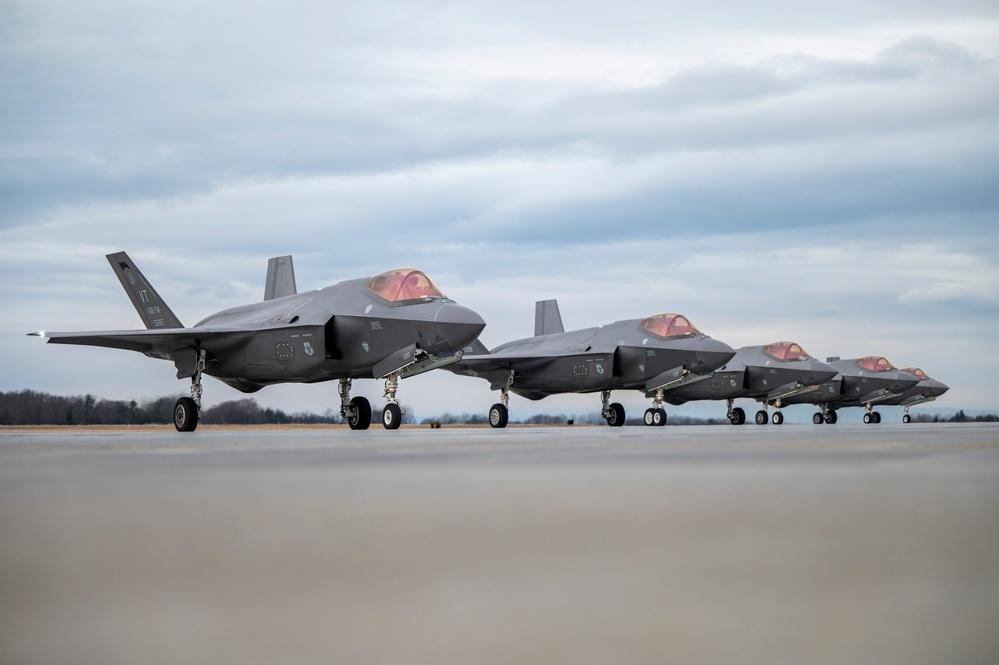U.S. undersecretary of defense William LaPlante called full-rate approval “a major achievement” for the F-35 program one day after the Air Force cut its 2025 purchases.
The Pentagon issued a statement on the approval on Tuesday, noting that LaPlante, approved the Milestone C / Full Rate Production of the F-35 with the signing of an Acquisition Decision Memorandum after a meeting with the Defense Acquisition Board (DAB).
Moving to full rate production requires stable control of the aircraft manufacturing process, acceptable performance and reliability, and the establishment of adequate sustainment and support systems according to DoD.
The F-35 achieved these benchmarks, successfully passing a Combined Initial Operational Test and Evaluation and Live Fire Test and Evaluation Report, “system development and demonstration exit criteria, statutory/regulatory documentation compliance, future production strategy, and draft acquisition program baseline details,” the release affirmed.
It’s progress but belated progress. The approval comes four years after DoD planned on green-lighting full F-35 production. It follows the long-awaited completion of key Joint Simulation Environment tests in September 2023.
The extensive series of tests put the Air Force, Marine Corps and Navy variants of the Joint Strike Fighter through simulated operational scenarios from air and cruise missile defense to suppression of enemy air defenses (SEAD) missions.
Lt. Gen. Mike Schmidt, director and program executive officer for the F-35 Joint Program Office (JPO) touted the improvements made in the multi-nation program over the last decade, enthusing that, “the Program and our great people can now focus on the future of the F-35 instead of the past.”
The F-35’s past is a long one. Derived from the Lockheed Martin
LMT
BA
The F-35 first flew in 2006. It entered service with the Marines (F-35B) in 2015, with the Air Force (F-35A) in 2016 and with the Navy (F-35C) in 2019. Initial production began in 2004. It has thus taken 20 years for the Lightning II to reach full-rate production.
About 24 hours before achieving this milestone, the Air Force announced that its provisional $217.5 billion budget for fiscal 2025 would see it request six fewer F-35As than expected, dropping from its buy 47 aircraft to 42.
The Air Force’s decision to purchase fewer F-35s takes some of the air from undersecretary LaPlante’s assertion that, “This decision—backed by my colleagues in the Department—highlights to the Services, F-35 Cooperative Program Partners, and Foreign Military Sales customers that the F-35 is stable and agile…”
The program’s stability was central to comments made by the Air Force’s assistant secretary for financial management and comptroller, Kristyn Jones, who told reporters on Monday that delays in the F-35’s Technology Refresh 3 (TR-3) played a role in the decision to acquire fewer F-35s alongside budgetary constraints.
Delays in completing development of TR-3 by Lockheed Martin have led the Pentagon to refuse delivery of new-build Lightning IIs since July 2023. Defense News quoted Jones’ explanation for the cutback and its link to the TR-3 delay.
“We want the planes that we want, and TR-3 [and] Block 4 capabilities have been delayed… Our approach is to minimize the impact of that by procuring fewer of those…”
F-35 annual purchases are expected to bounce back 48 per year in fiscal 2029 but that’s five years into a future in which an enormous amount can (and probably will) change. I put several questions to the F-35 JPO regarding the go-ahead for full rate production and concurrent reduction in the Lighting II buy.
The questions ranged from whether the full-rate production approval signals potential acceptance of undelivered F-35s by the government earlier than the projected summer timeline to whether the JPO recognizes the irony of full-rate approval just as the USAF slows its F-35 purchases.
As of this afternoon, the JPO had yet to offer responses. In practice, full-rate production approval will have little effect on the F-35 assembly line. As I’ve pointed out in previous articles, Lockheed Martin is already producing the jets at a rate of 150 per year, its long-planned capacity.
According to DoD, over 990 F-35s have been delivered to the U.S. Air Force, Navy and Marine Corps as well as allies and foreign military sales customers. The latter will surely have noticed the slight dip in U.S. demand for the fighter it has at long last cleared for full-rate production.
Read the full article here





